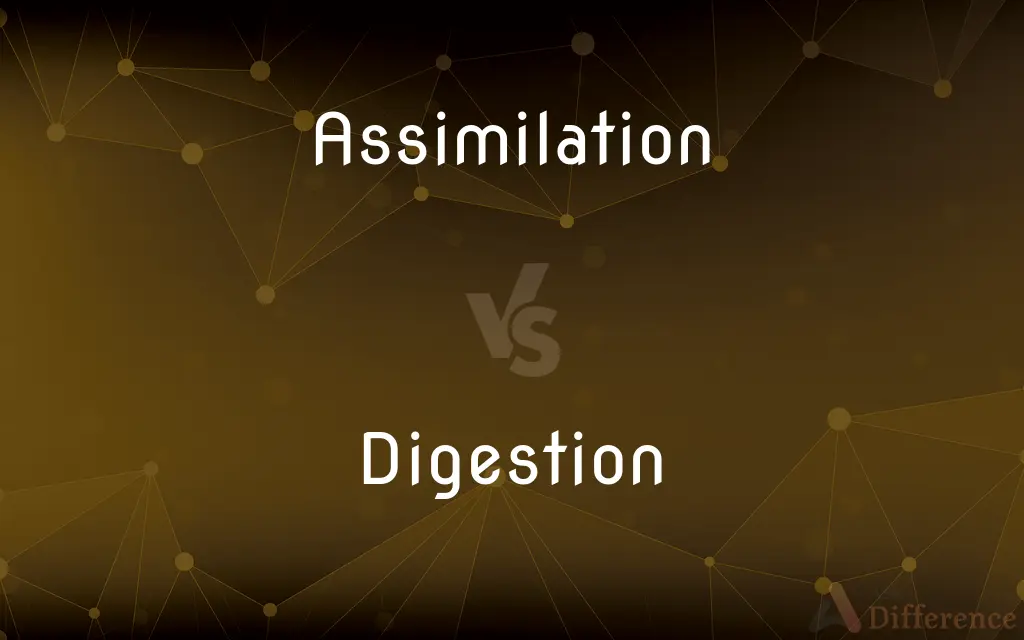Assimilation vs. Digestion — What's the Difference?
Edited by Tayyaba Rehman — By Fiza Rafique — Updated on April 3, 2024
Assimilation transforms absorbed nutrients into bodily substances, crucial for energy and growth, whereas digestion breaks down food into simpler forms, enabling nutrient absorption.

Difference Between Assimilation and Digestion
Table of Contents
ADVERTISEMENT
Key Differences
Assimilation and digestion are integral processes of the human body, working together to convert food into energy and vital components for survival. While digestion involves the breakdown of food into nutrients that can be absorbed by the body, assimilation refers to the further processing of these absorbed nutrients, integrating them into bodily tissues for energy, growth, and repair. This indicates digestion's role in nutrient extraction, whereas assimilation focuses on the utilization of these nutrients.
The process of digestion begins in the mouth and continues through the stomach and intestines, involving both mechanical and chemical actions to break down complex food particles. Assimilation, on the other hand, occurs after digestion, primarily within the cells of various tissues, where the absorbed nutrients are used to produce energy, build new cells, and maintain bodily functions.
Digestion is marked by the action of enzymes and other digestive juices that convert complex foods into simpler substances like glucose, amino acids, and fatty acids. While assimilation involves the metabolic pathways that transform these simple substances into the components necessary for the body, such as proteins, nucleic acids, and lipids.
In terms of outcome, digestion prepares nutrients for absorption through the digestive tract's walls into the bloodstream. Assimilation ensures these nutrients contribute to the body's metabolic needs, supporting activities like muscle contraction, cell division, and hormone synthesis.
While digestion can be influenced by dietary choices and digestive health, assimilation's efficiency is affected by factors like overall health, metabolic rate, and the presence of necessary co-factors for biochemical reactions. This distinction highlights the dependency of assimilation on the success of digestion and the body's metabolic state.
ADVERTISEMENT
Comparison Chart
Primary Function
Breaks down food into absorbable nutrients
Integrates nutrients into bodily substances
Location
Mouth, stomach, intestines
Cells of various tissues
Process Type
Mechanical and chemical
Metabolic
Enzymes Involved
Amylase, protease, lipase, etc.
Various enzymes for metabolic pathways
Outcome
Nutrients made available for absorption
Nutrients used for energy, growth, repair
Compare with Definitions
Assimilation
Conversion of nutrients into body tissue.
Assimilation is crucial for muscle growth.
Digestion
Conversion of proteins into amino acids.
The digestive system breaks down proteins for absorption.
Assimilation
Integration of absorbed nutrients for energy.
Assimilation processes glucose into energy.
Digestion
Breakdown of carbohydrates into sugars.
Digestion converts starches into simpler sugars.
Assimilation
Use of amino acids to synthesize proteins.
During assimilation, amino acids become part of the body’s proteins.
Digestion
Emulsification of fats for absorption.
Digestion involves emulsifying fats into fatty acids.
Assimilation
Cellular level nutrient processing.
Assimilation occurs within the cells, transforming nutrients.
Digestion
Begins in the mouth with saliva.
Digestion starts with chewing and saliva in the mouth.
Assimilation
Supports bodily functions and repair.
Assimilation helps in repairing damaged tissues.
Digestion
Involves stomach acids and enzymes.
Stomach acids play a key role in digestion.
Assimilation
The process of taking in and fully understanding information or ideas
The assimilation of the knowledge of the Greeks
Digestion
The process by which food is converted into substances that can be absorbed and assimilated by a living organism. In most animals it is accomplished in the digestive tract by the mechanical and enzymatic breakdown of foods into simpler chemical compounds.
Assimilation
The absorption and digestion of food or nutrients by the body or any biological system
Nitrate assimilation usually takes place in leaves
Digestion
The ability to digest food.
Assimilation
The process of becoming similar to something
Watson was ready to work for the assimilation of Scots law to English law where he thought it was justified
Digestion
(Biochemistry) The process of decomposing complex organic substances into simpler substances, as by the action of enzymes or bacteria.
Assimilation
The act or process of assimilating.
Digestion
(Chemistry) The process of softening or disintegrating by means of chemical action, heat, or moisture.
Assimilation
The state of being assimilated.
Digestion
Assimilation of ideas or information; understanding.
Assimilation
(Physiology) The conversion of nutriments into living tissue; constructive metabolism.
Digestion
The process, in the gastrointestinal tract, by which food is converted into substances that can be utilized by the body.
Assimilation
(Linguistics) The process by which a sound is modified so that it becomes similar or identical to an adjacent or nearby sound. For example, the prefix in- becomes im- in impossible by assimilation to the labial p of possible.
Digestion
The result of this process.
Assimilation
The process whereby a minority group gradually adopts the customs and attitudes of the prevailing culture.
Digestion
The ability to use this process.
Assimilation
The act of assimilating or the state of being assimilated.
Digestion
The processing of decay in organic matter assisted by microorganisms.
Assimilation
The metabolic conversion of nutrients into tissue.
Digestion
The assimilation and understanding of ideas.
Assimilation
(by extension) The absorption of new ideas into an existing cognitive structure.
Digestion
Generation of pus; suppuration.
Assimilation
(phonology) A sound change process by which the phonetics of a speech segment becomes more like that of another segment in a word (or at a word boundary), so that a change of phoneme occurs.
Digestion
(chemistry) Dissolution of a sample into a solution by means of adding acid and heat.
Assimilation
The adoption, by a minority group, of the customs and attitudes of the dominant culture.
Digestion
The act or process of digesting; reduction to order; classification; thoughtful consideration.
Assimilation
The act or process of assimilating or bringing to a resemblance, likeness, or identity; also, the state of being so assimilated; as, the assimilation of one sound to another.
To aspire to an assimilation with God.
The assimilation of gases and vapors.
Digestion
Generation of pus; suppuration.
Assimilation
The conversion of nutriment into the fluid or solid substance of the body, by the processes of digestion and absorption, whether in plants or animals.
Not conversing the body, not repairing it by assimilation, but preserving it by ventilation.
Digestion
The process of decomposing organic matter (as in sewage) by bacteria or by chemical action or heat
Assimilation
The state of being assimilated; people of different backgrounds come to see themselves as part of a larger national family
Digestion
The organic process by which food is converted into substances that can be absorbed into the body
Assimilation
The social process of absorbing one cultural group into harmony with another
Digestion
Learning and coming to understand ideas and information;
His appetite for facts was better than his digestion
Assimilation
The process of absorbing nutrients into the body after digestion
Assimilation
A linguistic process by which a sound becomes similar to an adjacent sound
Assimilation
The process of assimilating new ideas into an existing cognitive structure
Assimilation
In the theories of Jean Piaget: the application of a general schema to a particular instance
Common Curiosities
Can digestion occur without assimilation?
Digestion can occur without effective assimilation if there are metabolic or absorption issues.
What is the main difference between assimilation and digestion?
Digestion is the breakdown of food into nutrients, while assimilation is the integration of these nutrients into bodily tissues.
How do dietary choices affect digestion and assimilation?
Dietary choices directly impact digestion's efficiency and indirectly affect assimilation by providing necessary or harmful nutrients.
Is assimilation the same in all organisms?
While all organisms assimilate nutrients, the process and mechanisms can vary widely among different species.
Where does assimilation primarily occur?
Assimilation primarily occurs at the cellular level in various tissues throughout the body.
What role do enzymes play in digestion?
Enzymes catalyze the breakdown of complex food molecules into simpler, absorbable nutrients during digestion.
How is assimilation related to metabolism?
Assimilation is a part of metabolism, specifically the anabolic pathways that build complex molecules from simpler ones.
Is water important for digestion and assimilation?
Yes, water plays a crucial role in both digestion and the transport of nutrients for assimilation.
How does poor digestion affect assimilation?
Poor digestion leads to inadequate nutrient absorption, thus impairing the assimilation process.
Do probiotics affect digestion and assimilation?
Probiotics can improve digestive health, potentially enhancing both digestion and nutrient assimilation.
What factors can disrupt digestion?
Factors like poor diet, stress, and digestive disorders can disrupt normal digestion.
What is the role of the liver in assimilation?
The liver plays a key role in assimilating and processing nutrients, including detoxification and storage.
How does physical activity impact assimilation?
Physical activity can enhance metabolic rate and thus may improve the efficiency of assimilation.
Can assimilation affect body weight?
Yes, efficient assimilation of nutrients supports energy production and tissue building, which can influence body weight.
Can assimilation be measured?
While challenging, assimilation efficiency can be inferred through nutritional status, growth rates, and specific biochemical markers.
Share Your Discovery

Previous Comparison
Constant vs. Sustained
Next Comparison
Suede vs. ChamoisAuthor Spotlight
Written by
Fiza RafiqueFiza Rafique is a skilled content writer at AskDifference.com, where she meticulously refines and enhances written pieces. Drawing from her vast editorial expertise, Fiza ensures clarity, accuracy, and precision in every article. Passionate about language, she continually seeks to elevate the quality of content for readers worldwide.
Edited by
Tayyaba RehmanTayyaba Rehman is a distinguished writer, currently serving as a primary contributor to askdifference.com. As a researcher in semantics and etymology, Tayyaba's passion for the complexity of languages and their distinctions has found a perfect home on the platform. Tayyaba delves into the intricacies of language, distinguishing between commonly confused words and phrases, thereby providing clarity for readers worldwide.
















































